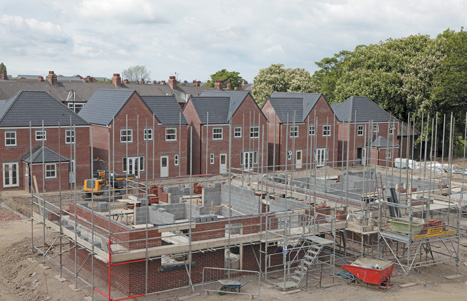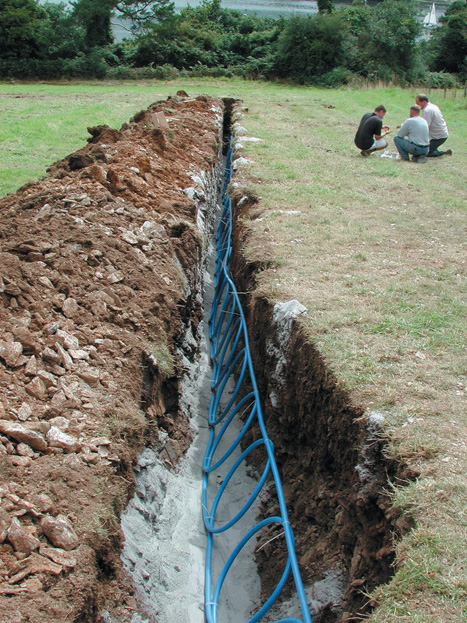The construction sector has been hit harder than most by the economic turmoil of the past couple of years, and with the private sector curbing spending, and the public sector restraining investment, it faces a long and arduous road to recovery.
But despite its travails, one area of the construction industry is in relatively rude health, and ambitious carbon reduction targets are driving the development of a range of technologies and techniques that promise to usher in a new era of low-carbon housing.

The government is playing a critical role. The CRC energy-efficiency scheme has been introduced, building regulations have been tightened and the plans for all new homes to be zero carbon by 2016 have been clarified. The coalition government, which claims to be the ’greenest government ever’, last year announced the Green Deal, which will be introduced in 2012 to address the lack of investment in energy-saving measures.
Alongside this has been the implementation of the feed-in tariff a scheme that provides money in return for domestic energy generated from renewable sources. The government has also recently outlined details of its Renewable Heat Incentive (RHI) policy in an attempt to improve the way heat is generated in buildings and homes. This will include financial support for a range of technologies and fuel uses, including solid and gaseous biomass, solar thermal and ground source heat pumps.

For Michael Woodhead, managing director of E.ON Sustainable Energy, ground-source heat pumps could particularly valuable technology for existing housing stock. These systems circulate a mixture of water and antifreeze around a loop of pipe buried in the ground. Ambient heat from the ground is absorbed into the fluid and pumped through a heat exchanger. Low-grade heat passes through the heat-pump compressor and is concentrated into a higher-temperature heat capable of use within the home. The ground loop fluid then passes back into the ground where it absorbs further energy in a continuous cycle.
“Like anything, there is a challenge in funding these building projects, despite their long-term benefits”
’Ground-source heat pumps are particularly good in areas that are not on gas,’ said Woodhead. ’There are some challenges in installing them more from the point of view of having the proper processes in place and there have been some challenges again with regards to some people doubting the technology. But I have to say, I think from a technology point of view, there aren’t any issues…For us, it’s a system for use in retrofit rather than in new properties where we’re looking at district heating solutions.’
District heating where centrally generated heat is distributed around a community is taking place in Cranbrook near Exeter, where E.ON is working with five developers to build one of the largest district heating schemes outside London. The scheme will see 3,500 homes, a 107-acre park and a 1,400,000ft2 business park connected to a district heating network through an energy centre. The low-carbon heat source will change as the developments grow, with gas-fired boilers being supplemented by gas-fired combined heat and power (CHP), and later by biomass-fuelled CHP. Heat will be distributed from a central source to the community via a network of underground pipes.

’Rather than each of these houses having their own individual boilers, we’re creating the heat centrally so it’s far more sustainable,’ said Woodhead. ’Like anything, there is a challenge in funding these projects despite their long-term benefits. Another difficulty can be with regard to the builders themselves, and whether or not they’ve been able to accept or believe that they can actually sell their properties on the basis that they haven’t got gas connection to them. Interestingly, although this is perceived to be an issue, we’ve got a lot of projects now that our building partners have agreed to take forward on that basis.’
A green energy source is not the only factor to consider. Woodhead believes that a three-pronged strategy to sustainable buildings is needed: insulate, moderate and generate. Around 85 per cent of the buildings that exist today will still exist in 2050 and so retrofitting energy-efficient systems is high up on the government’s list of priorities. But this can be a lot more difficult than starting from scratch, and the solution will be different for each type of building. For a large number, however, better insulation is the first step to improving efficiency.
“Rather than each house having its own boiler, we’re creating the heat centrally”
MICHAELWOODHEAD, E.ON
This is the main drive behind ’Passivhaus’ a voluntary standard for energy-efficient buildings that use less than 15kWh/m2/yr space for heating and cooling systems and less than 120kWh/m2/yr primary energy usage for all appliances, hot water and heating. Passivhaus buildings typically use superinsulation, cavity walls and triple-glazing to minimise heat loss by around 90 per cent compared with a standard building. A Passivhaus essentially heats itself by retaining the warmth generated by electrical devices and its occupants, as well as using mechanical ventilation with a heat-recovery system.
Mike Hope, a partner at Roderick James Architects, converted his own home using Passivhaus principles. ’It’s a real minefield trying to decide what technologies and materials to use,’ he said. ’I’m in the game and even I can get very confused. Luckily, despite it being more difficult to decide on the technology, with refurbishments and extensions there is more leeway with building regulations.’
Fitting efficient lighting can be another way to moderate energy and reduce a building’s carbon footprint, both within existing buildings and new ones. Lighting accounts for 20 per cent of global energy consumption, and in some commercial environments as much as 50 per cent. As well as energy-efficient lightbulbs, compact fluorescent lights and light-emitting diodes, there are a range of other possibilities, such as sunlight transportation, that could be seen in future buildings.
For instance, Swedish company Parans has developed a sunlight transportation system that uses rooftop panels to collect natural sunlight and transport it via fibre-optic cables to rooms throughout the house. Light-emitting luminaries on the ceiling then give off a mixture of parallel light and ambient light to give the impression of standing under the foliage of a tree when the sun strikes through. Similar sunlight transportation systems can be used in combination with solar panels to combine natural and artificial light systems and improve energy efficiency.
Whether it is in the materials, lighting, energy source, construction method or building architecture, our buildings will undergo major changes in the coming years. Getting the right balance of technologies and finance will be tricky. But as we move towards a sustainable future, the construction and green industries will need to work together if they are to harness the significant energy savings that could be made in our built environment.
in depth slow burn
The government plans a phased approach to its RHI schemeThe Renewable Heat Incentive (RHI) is aimed at accelerating deployment of energy-efficient technology by providing a financial incentive to install renewable heating in place of fossil fuels. The government is planning to take a phased approach to its implementation.
Initially, long-term tariff support will be targeted at the big emitters in the non-domestic sector. In July 2011, the government will also introduce £15m-worth of Renewable Heat Premium Payments for the domestic sector. These direct payments will subsidise the cost of installing qualifying renewable heating systems. In return for the payments, participants will be asked to provide some feedback on how the equipment works.
A second phase of RHI support, including long-term tariff support for the domestic sector, will then be introduced in 2012 to coincide with the introduction of the Green Deal for Homes. People in receipt of the Renewable Heat Premium Payments will be able to receive long-term RHI tariff support once these tariffs are introduced, as well as anyone who has installed an eligible installation since 15 July 2009.




Nanogenerator consumes CO2 to generate electricity
Whoopee, they've solved how to keep a light on but not a lot else.